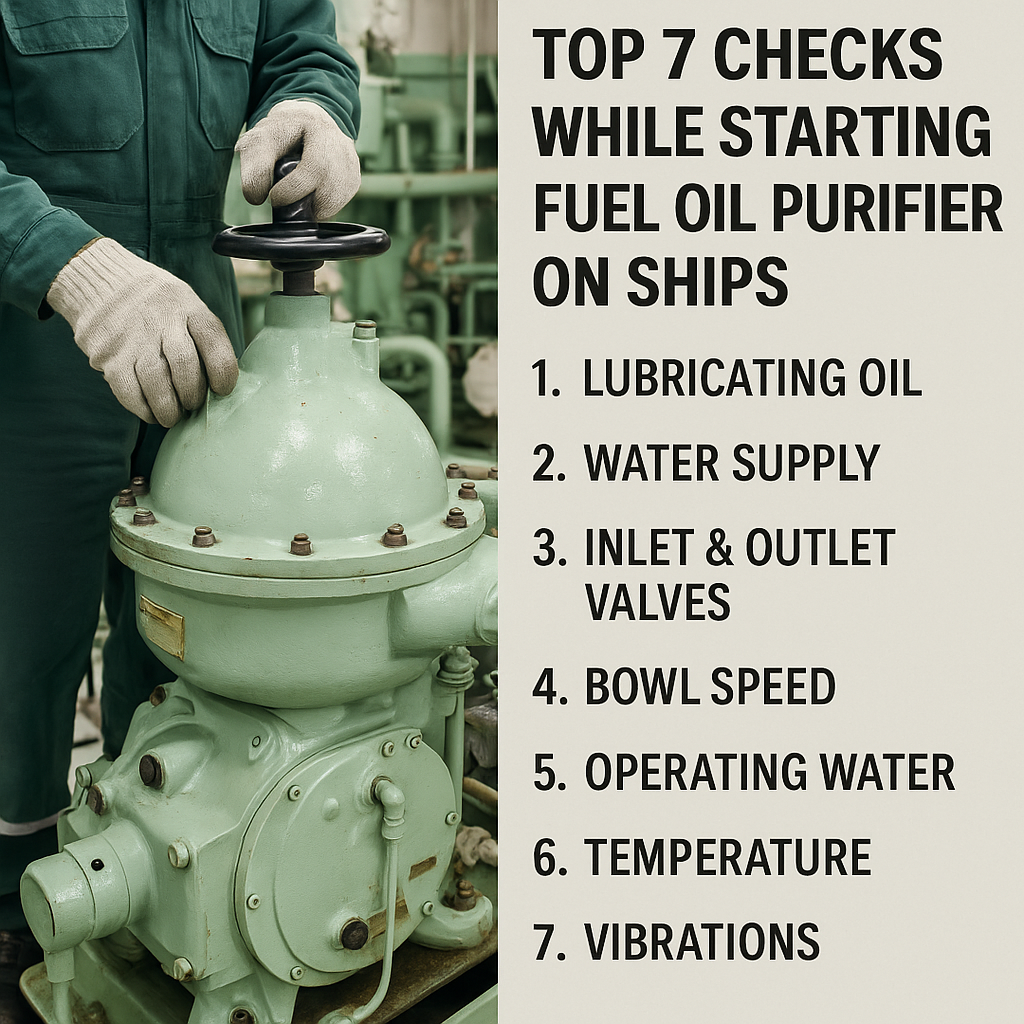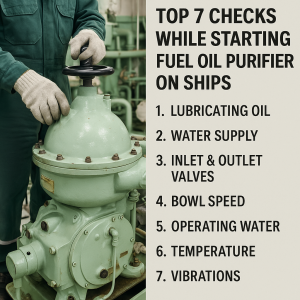Discover the 7 critical checks every engineer officer must perform before starting a ship’s fuel oil purifier. Learn best practices, compliance standards, and modern technologies in this complete guide.
Imagine this: you’re down in the engine room of a 90,000 DWT bulk carrier, where the temperature is well above 40 degrees Celsius, and the machinery hums like a living heartbeat. Among the most vital pieces of equipment keeping the ship’s main engine alive is the fuel oil purifier. It’s the ship’s silent guardian, quietly removing water and solid impurities from the fuel to protect expensive engine components.
If a fuel oil purifier is wrongly started, the consequences can be catastrophic — from contaminated fuel entering the main engine to costly breakdowns that leave a ship drifting mid-ocean. Regulatory frameworks such as SOLAS, MARPOL Annex VI, and Classification Society requirements place high importance on correct fuel handling and separation.
This article offers a practical, down-to-earth exploration of seven crucial checks every marine engineer should carry out before starting a fuel oil purifier. Real-life experiences, authoritative sources, and good marine engineering sense will guide us through.
Why Fuel Oil Purifiers Matter in Modern Marine Operations
Think of the purifier as the ship’s kidney. The modern marine engine burns tens of tonnes of fuel every day, and that fuel is rarely clean. Sludge, cat fines, water, microbial growth, or corrosion residues from bunker tanks can damage injection pumps, valves, or even cylinder liners.
According to Lloyd’s Register (2023), up to 70% of marine engine failures are linked to fuel-related problems, often from ineffective purification or contaminated bunkers. The purifier prevents those failures by:
-
Removing harmful solids and water
-
Maintaining fuel quality standards in line with ISO 8217
-
Protecting critical engine parts
-
Reducing maintenance cost and downtime
-
Supporting compliance with MARPOL’s sulphur cap
This is why a thorough pre-startup routine for fuel oil purifiers is a must, not an option.
The 7 Essential Checks Before Starting a Fuel Oil Purifier
Let’s break these down in an approachable, storytelling style that resonates with global maritime students and professionals.
Confirm Correct Fuel Oil Grade and Temperature
One of the most vital checks is ensuring that the correct fuel oil grade is lined up for the purifier and that its temperature is within the proper range.
Heavy fuel oils, for instance, need to be heated to a set temperature (usually 90–98°C) so their viscosity is suitable for separation. If the oil is too cold, it won’t flow properly; too hot, and it might flash or break down.
An example from the Marine Pollution Bulletin showed how a purifier on a VLCC failed after the operator forgot to verify fuel temperature. The purifier bowl clogged solid, risking engine starvation mid-voyage. A simple thermometer reading and line sampling would have avoided this.
Inspect and Clean the Strainer
Before circulating fuel to the purifier, the engineer must open, clean, and check the inlet strainer.
Why? Because this filter captures large debris before they can damage the purifier bowl. Strainers blocked with rust flakes, old sludge, or tank scale can restrict flow, starve the feed pump, and cause the purifier to trip on low pressure.
Modern purifiers may have pressure sensors on the inlet, but there is no substitute for a manual check. As Alfa Laval and Wärtsilä recommend in their manuals, strainer cleaning should be routine whenever the purifier is started.
Ensure Sufficient Feed and Discharge Lines Are Open
It sounds basic, but you’d be surprised how often engineers overlook it, especially under port pressure.
Verify the following:
-
Feed line valves are open
-
Discharge to clean oil tank is lined up
-
Sludge line to the sludge tank is clear
-
Heating steam lines are ready (if installed)
A cross-check of these lines guarantees that fuel can move safely through the purifier cycle, preventing back-pressure, overflows, or even flooding of the purifier casing.
Verify Bowl Assembly and Locking
If you have cleaned or overhauled the purifier recently, double-check that the bowl is correctly assembled and properly locked.
Most catastrophic purifier failures happen when the bowl is left loose. That’s a spinning chunk of metal rotating at up to 10,000 rpm — if it flies apart, people can get killed.
Always check:
-
Lock ring tightened
-
Bowl nut torqued correctly
-
No leftover tools inside the bowl
Many engineers add this to their “double-check” list — a small mistake can become a million-dollar disaster.
Confirm Lubrication and Seal Oil Supply
A purifier’s bearing and gear train need lubrication oil, while its water seal or oil seal protects the high-speed bowl.
Before starting, check that:
-
The purifier gearbox sump is filled to correct levels
-
Oil piping is free from leaks
-
Seal water or seal oil pressure is available
A seal failure at 10,000 rpm could spill fuel into the engine room or cause a fire. In 2021, a bulk carrier reported purifier fires traced back to a failed water seal that was never checked during startup (source: Marine Accident Investigation Branch UK).
Test Safety Devices and Alarms
Modern purifiers have a series of safety devices:
-
High sludge alarm
-
High water alarm
-
High temperature shutdown
-
Over-speed trip
Run through their test function before hitting start. A faulty sensor could mask dangerous sludge buildup or allow water to flood into clean fuel, damaging the main engine.
In a world of ECA (Emission Control Area) requirements, the purifier must work perfectly to avoid environmental penalties for off-spec fuel.
Check for Abnormal Noise or Vibration
Finally, once the purifier starts to rotate, pause for a moment. Listen. Feel.
If you hear an unusual metallic ring, sense a hard vibration, or see the purifier frame shaking, shut it down immediately.
-
Uneven vibration may signal bowl imbalance
-
Loud knocking can mean bearing damage
-
Smell of burnt oil may hint at slipping belts or a failing motor
Trust your human senses. No monitoring screen can replace an engineer’s instinct for how the machinery should sound.
Case Study: When Checks Go Wrong
In 2019, a container vessel sailing in the Mediterranean suffered a main engine blackout when contaminated fuel passed straight through the purifier. Investigators found:
-
The inlet strainer had never been cleaned
-
The bowl was loosely locked after overhaul
-
Alarm sensors were in bypass mode
This single error cascaded into a three-day delay, port fines, and a near collision with another vessel. That event underlines why these 7 checks are not “nice to have” — they are life-critical.
Key Technologies and Developments Driving Change
The purifier world is not stuck in the past.
-
Modern automatic self-cleaning purifiers
-
Digital flow monitoring and viscosity sensors
-
Smart IoT-connected alarms
-
Integrated condition monitoring tied to PMS (Planned Maintenance Systems)
Class societies like DNV and ABS encourage these upgrades, seeing a 15–20% drop in purifier-related failures thanks to digital oversight (DNV Annual Report, 2023).
Challenges and Solutions
Challenge: Inexperienced junior engineers neglecting checks
Solution: Mentoring, shipboard checklists, and drills
Challenge: Tight port schedules rushing startup
Solution: Incorporate purifier startup as a standing part of the port arrival/departure checklist
Challenge: Over-reliance on automation
Solution: Regular manual inspection training
Future Outlook
Fuel oil purification will evolve rapidly.
-
Alternate fuels like biofuels and synthetic blends will push purifiers to adapt
-
Class societies may soon mandate even stricter separation quality
-
AI-supported predictive maintenance will make condition-based monitoring standard
Yet, one truth will remain: an engineer’s skill and attention are still the ship’s best safety net.
FAQ
Why is fuel oil purification critical on ships?
To prevent contaminants from damaging the main engine and to stay compliant with IMO sulphur limits.
How often should the purifier be cleaned?
Usually once every 500–1,000 running hours, or as recommended by the maker.
What happens if the purifier bowl is not locked properly?
It could fly apart, damaging equipment and risking crew safety.
Can you run the purifier without seal water?
No — the seal protects against leaks and maintains safe operation.
Do you need to check the fuel temperature?
Always. Heavy fuels must be at the correct viscosity for separation.
Conclusion
On board a ship, the fuel oil purifier is your invisible ally. It works tirelessly behind the scenes to ensure your expensive main engine gets clean, stable fuel. But it can only do its job if you, the engineer, respect it.
Checking strainers, temperatures, valves, lubrication, bowl locks, safety alarms, and that first whir of vibration are not small things — they are the difference between smooth sailing and a serious incident.
As shipping moves forward into cleaner fuels, digital control, and stricter regulations, these traditional checks will remain essential for safe, reliable operations. So the next time you stand by the purifier panel, pause, think, and trust these 7 checks — your ship will thank you for it.
References
-
Lloyd’s Register. Marine Fuel Oil Purification Trends 2023. https://www.lr.org
-
Alfa Laval. Centrifugal Separator Operating Manual https://www.alfalaval.com
-
Marine Accident Investigation Branch (UK). Investigation Reports 2021 https://www.gov.uk/maib-reports
-
DNV. Fuel Quality Challenges and Solutions 2023 https://www.dnv.com
-
IMO. MARPOL Annex VI Guidelines https://www.imo.org


